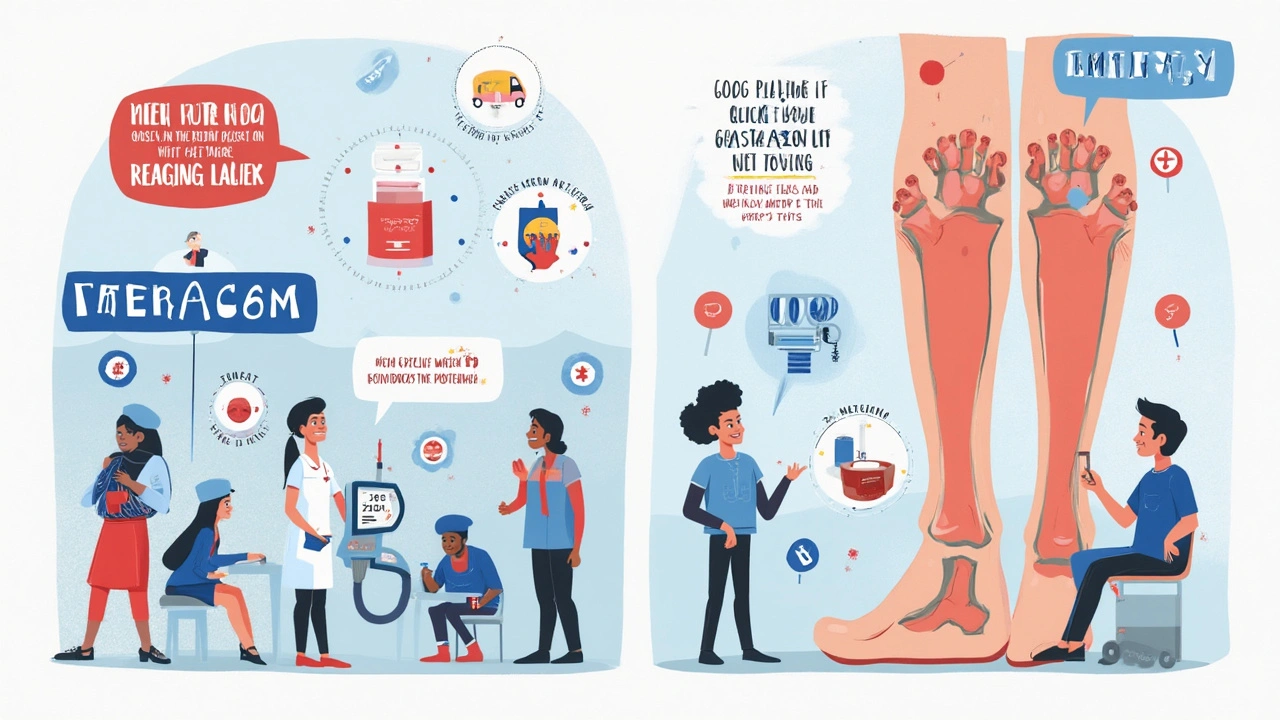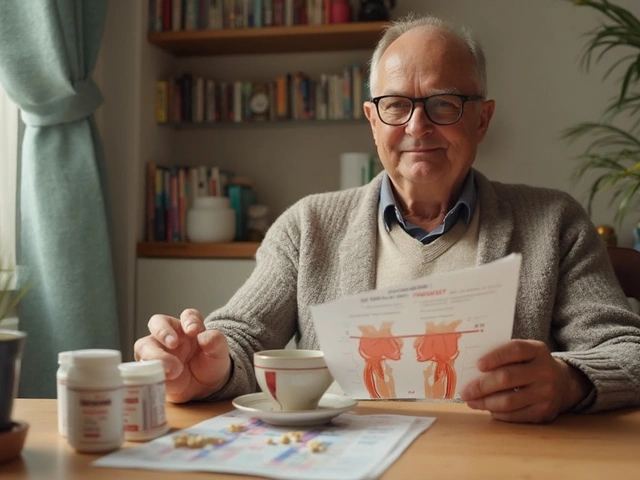Terazosin and Gout: How This Blood Pressure Drug Impacts Uric Acid Levels

If you’ve got gout, the last thing you need is a surprise from your blood pressure meds. Yet here we are: terazosin, a pill known for taming high blood pressure and easing symptoms of an enlarged prostate, sometimes pops up in conversations about gout. Your doctor may have handed you a prescription without a single mention of uric acid or flare-ups. So, is terazosin helping, hurting, or just minding its business when it comes to your gout?
The Science of Terazosin: What Does It Actually Do?
Terazosin is part of a family of drugs called alpha blockers. These meds mainly relax certain muscles and help small blood vessels stay open, making them popular for people with high blood pressure or benign prostatic hyperplasia (that’s doctor-speak for enlarged prostate). But their job doesn’t end there. The body’s all connected, right? Turns out, terazosin’s effect on blood vessels can also have a subtle knock-on effect for other processes, including how your body deals with uric acid.
When you break it down, gout is all about uric acid. Uric acid is a natural waste product, but if your kidneys don’t clear it out fast enough, it builds up and forms sharp little crystals in your joints. Cue red, swollen, can’t-even-look-at-it toes—the classic gout attack. Some meds, like certain diuretics, are well-known gout triggers because they make your kidneys hold onto uric acid. But with terazosin, the story is surprisingly different.
Unlike a lot of blood pressure pills, alpha blockers aren’t famous for raising uric acid. In fact, a study published in the Journal of Human Hypertension back in 2016 looked at a group of folks on terazosin and found their uric acid levels actually decreased slightly over time. Now, that doesn’t mean terazosin is a miracle cure for gout. The difference isn’t massive—like shaving off a few points rather than wiping out the whole score—but it’s worth noting in a world where plenty of medications tip things in the wrong direction.
Why this happens? The working theory is that by relaxing blood vessel walls and encouraging better kidney blood flow, your body gets just a little bit better at filtering out uric acid. It’s not dramatic, but when it comes to gout, every bit helps. Keep this in mind if you’re comparing new blood pressure options. And, if your doctor switches out terazosin for a diuretic, ask about what that means for your gout risk.

Terazosin, Gout, and The Real-World Patient Experience
Now, let’s talk reality. Maybe you’re managing both high blood pressure and gout—double whammy, right? There’s this idea floating around in some online forums that terazosin could either worsen gout (like some old-school BP meds) or be a secret hack for preventing flares. So, what do actual patients experience?
First up, the evidence doesn’t show that terazosin makes gout flares worse. That’s a relief if you’ve ever had to crawl to the fridge during an attack. Plenty of gout patients on terazosin report either no change in their symptoms or notice their uric acid levels creep down just a little on lab tests. That study I mentioned earlier? The researchers tracked patients for six months and saw a mean drop of just over 0.2 mg/dL in uric acid—not huge, but in the right direction.
Still, there are some side effects to keep on your radar. Terazosin can drop your blood pressure a bit too low, especially when you first start. If you stand up quickly and blackout or get super dizzy, that’s a sign to call your doctor. Dehydration matters too. Some folks, worried about fainting, end up drinking less water. Big mistake—staying hydrated is key for flushing uric acid out and keeping gout at bay. So, if you’re on terazosin and you notice you’re thirstier or peeing more, don’t cut fluids. Double down on your water intake instead.
Here’s a good tip: track your uric acid levels with your routine blood work. If you’re prone to gout attacks, ask your doctor to add this test. Then, if you ever have to switch meds—say, to a thiazide diuretic that’s more likely to spike uric acid—you’ll have a baseline and can compare numbers. It puts the power back in your hands.
Let’s pause for a second and look at a quick data snapshot. Below you’ll see a sample table comparing the effects of different high blood pressure meds on uric acid, based on recent studies and summary guidelines:
| Medication Type | Uric Acid Impact | Common Use |
|---|---|---|
| Thiazide Diuretics | Increase (moderate to high) | Blood Pressure |
| Loop Diuretics | Increase (moderate) | Heart Failure, BP |
| Beta Blockers | Variable/Minimal | Blood Pressure |
| Calcium Channel Blockers | Decrease or No Change | Blood Pressure |
| Terazosin (Alpha Blocker) | Slight Decrease | Blood Pressure, Prostate |
That’s where terazosin stands out for people dealing with both high blood pressure and gout. It doesn’t pile on extra risk and may even help you nudge your numbers in the right direction. Now, as with any drug, there are always exceptions—so personal experience matters. Don’t ignore weird aches or new pains and blame gout for all of them. If something’s off, flag it with your doctor.
I want to share a quote I stumbled on from Dr. Mary Ann Markey, a rheumatologist who’s seen every kind of gout patient under the sun:
“Choosing the right treatment for each person is about more than just controlling one condition. Medications like terazosin can gently support kidney function and uric acid regulation, which matters far more to patients with gout than they realize. Don’t underestimate these small but positive effects.”
This is where personalizing your treatment plan pays off. What works for a friend or partner might not work for you, especially if you have several health conditions to juggle.

Smart Tips for Managing Gout While Taking Terazosin
Daily life with gout can feel like a minefield. Random flares, food warnings, and then—layered on top—new meds to remember. If terazosin’s in your pillbox, here’s what you can do to stack the odds in your favor and keep those uric acid crystals at bay.
- Stay on top of your hydration. Water helps your kidneys flush out uric acid, and terazosin won’t get in the way. In fact, skipping on water can make both low blood pressure and gout worse, so keep a bottle at hand.
- Stick to your diet plan. Sure, we all know to watch the shellfish and red meat, but also pay attention to sugar-sweetened drinks and heavy alcohol use. If you’re drinking more fluids because of terazosin, choose water over sodas or beers.
- Monitor your uric acid. Ask for this lab check at least every 6 to 12 months if you have gout or if you’re at high risk. It’s the only way to know if things are moving in the right direction.
- Don’t play doctor with your meds. Some people wonder, “Should I just double up on terazosin to kick my uric acid lower?” That’s not how it works—the benefit is small and only at the prescribed dose. Doubling up just risks dangerous side effects.
- If your doctor suggests switching to a medication that’s known for increasing uric acid, ask about your gout risk. There may be alternatives or ways to adjust your other medications.
And one last thing: pay attention to your body. If you suddenly get joint pain in a spot you never had before, mention it. Sometimes what feels like gout could be a side effect, or another problem altogether. Don’t just assume.
With terazosin, you’re in a good spot compared to other blood pressure meds. The relationship between terazosin and gout isn’t shady or mysterious: it’s mostly friendly, with maybe a little bonus for uric acid clearance. Take a proactive approach, and don’t let sneaky fears about your meds keep you from getting your blood pressure (and your gout) under control.




Ari Kusumo Wibowo
Honestly, I never thought about blood pressure meds messing with gout before. Terazosin affecting uric acid levels seems like it could be a big deal for a lot of people dealing with both issues.
It’s good to see an article that digs into actual science, not just rumors. I mean, managing one chronic condition is rough enough without meds making another one worse.
But, does the article say if terazosin raises or lowers uric acid? Because that changes everything, right? Some drugs can help reduce uric acid, but if this one makes it worse, that’s a huge problem.
Anyway, I’m interested in what kind of practical tips it offers. Anyone tried switching meds based on these findings or talked to their doc about it?
Feels like patients need to be way more proactive and educated about what their meds are doing. We should not just blindly trust prescriptions without understanding their effects fully.
I’d love to hear others’ experiences, especially if you’ve dealt with this combo of conditions.
Let’s get some real talk going here.
Hannah Gorman
This article could not have come at a more crucial time considering the complexity involved in simultaneously managing hypertension and gout, two conditions often seen side by side in clinical practice. It’s paramount to not only comprehend the pharmacodynamics of terazosin in lowering blood pressure but also to unravel how it might inadvertently influence the patient’s uric acid metabolism.
Elevated uric acid is the cornerstone of gout pathology, and any medication that modifies this biochemical milieu demands meticulous scrutiny. The piece seems to provide a nuanced explanation that transcends simplistic claims and instead equips the reader with the necessary intellectual tools to engage in meaningful dialogue with healthcare providers.
Moreover, clarifying common misconceptions that pervade patient communities about terazosin’s impact is a service that should be lauded. It’s not every day that one comes across such a comprehensive and didactic approach to what could otherwise be a very bewildering pharmacological topic.
For practitioners and patients alike, this could serve as an indispensable resource.
I would, however, have appreciated more detailed exploration into the molecular mechanisms at play, but perhaps that’s a discussion best reserved for a more specialized forum.
Tatiana Akimova
Wow, this is exactly the kind of straightforward, no-nonsense info we need on meds like terazosin. I mean, blood pressure and gout are already tough enough without medicine sneaking in side effects that could throw everything off balance.
Seriously, it’s refreshing to see an article that backs everything up with science rather than just spitting out scare tactics or myths.
Managing your health isn’t just about popping pills; it’s understanding how those pills work and what they might be doing behind the scenes.
If terazosin is influencing uric acid levels, whether up or down, that directly affects gout flare-ups and patient quality of life.
People need to be empowered enough to bring this up with their doctors. Don’t just accept whatever you’re prescribed—ask questions and request monitoring of uric acid if gout’s a concern.
Also, love that the article includes real-world tips. Knowing what to watch for is key—it’s those subtle symptoms that can alert you to problems escalating.
Keep these kinds of posts coming!
Calandra Harris
Are we seriously still ignoring how much our national health system fails when it comes to detailed patient education?
Terazosin could be messing with people’s uric acid and no one’s asking the tough questions at the pharmacy counter. It’s not just about taking the pill, it’s about understanding what that pill is doing to your body.
Gout is a disease of excess, and if terazosin is tipping that scale? We should know. We must know.
Everyone deserves clear, brutal honesty from their docs, not some watered down PR gloss aimed to keep our heads down.
I’m tired of the passive acceptance that assumes patients can’t handle complexity.
This article shreds some myths, but it’s on us to demand more transparency and accountability.
Call out your doctors if you must, because silence doesn’t cure anything.
Dan Burbank
My very serious qualm with this discussion is that it borders on simplistic interpretation when, of course, the biochemical interactions involving terazosin and uric acid are multifaceted and deeply contextual.
It would be intellectually negligent to suggest a one-size-fits-all impact when myriad factors including genetics, diet, comorbid conditions, and concurrent medications must be considered.
Furthermore, the elevated uric acid levels often cited as the sole culprit in gout oversimplify an inflammatory cascade that is anything but straightforward.
Proposals for patient education must, therefore, be accompanied by equally rigorous professional guidance to prevent misinterpretation and undue anxiety.
While I commend the efforts to demystify consequences of terazosin usage, it is crucial to maintain a nuanced view that respects the complexity of human physiology and medicine.
Anna Marie
This article seems to be a very thoughtful and well-balanced resource; from the perspective of a healthcare provider, I find such information indispensable for fostering a productive dialogue between patients and their healthcare teams.
Considering that terazosin is commonly prescribed, awareness of its potential effects on uric acid levels is important to preemptively manage gout risks without causing undue alarm.
Patients dealing with both hypertension and gout deserve to have clear information, so they can observe their symptoms effectively and understand when to seek medical advice.
Moreover, practical tips on how to handle these overlapping conditions can aid patients in feeling more in control of their health outcomes.
Emphasizing communication with one’s doctor as the article does ensures that medical decisions remain individualized and context-specific.
I appreciate the article’s avoidance of emotive language and its focus on precise, evidence-based guidance.
Clear, compassionate education like this can make a significant difference.
Abdulraheem yahya
Wow, finally some clarity on how terazosin influences uric acid levels, something that often gets overlooked in our local clinics where resources are limited.
As someone who deals with blood pressure and has witnessed family members struggle with gout, this connection is a real eye-opener.
The article does a fine job explaining the science in a digestible way, making it easy for patients like me to grasp why monitoring uric acid levels is crucial alongside blood pressure management.
Understanding these interactions empowers us to make better lifestyle choices, like adjusting diet or insisting on regular blood tests during doctor visits.
Sometimes it’s the small practical tips that make the biggest difference in daily life.
It would be great if more healthcare workers in my area could get access to such comprehensive yet accessible information.
Definitely sharing this with my community to encourage better self-advocacy in managing complex health issues.
Preeti Sharma
While I appreciate the intentions behind this breakdown of terazosin’s impact on gout, I find myself skeptical about oversimplifying the interaction between medication and disease.
There’s a tendency to reduce complex physiological phenomena into neat cause and effect, but the reality is often much murkier.
Could terazosin's effect on uric acid levels possibly be a side effect rather than a direct pharmacological action?
Moreover, the narrative sometimes leans too heavily on promoting urgency that borders on alarmism without fully acknowledging individual variability in responses.
Philosophically speaking, the desire to control and predict health outcomes through medication interactions is understandable but perhaps naive.
Health is a dynamic system not easily tamed by simple explanations, and patients should be wary of narratives that promise tidy answers.
Discussion should remain open and nuanced.
Ted G
Honestly, does anyone else feel like this is just the tip of the iceberg? Like, the pharma companies push meds like terazosin without fully disclosing the long-term effects on stuff like uric acid.
It makes me wonder what other hidden side effects are out there that aren’t getting talked about because they don’t fit the profit model.
This article sheds some light, but it feels like a band-aid on a deeper issue—transparency in medication effects.
And who’s really monitoring patients over time? It’s often left to the patients themselves, which feels designed to fail.
I’m all for science-backed info, but I don’t fully trust what filters through official channels given all the corporate interests involved.
Watch closely for patterns because I bet this is just a small glimpse at what meds can do quietly.
Anyone else skeptical about the whole system?
King Shayne I
From my experience, having had to manage both hypertension and gout, I can attest to the importance of understanding how medications intersect.
Terazosin did seem to have some effect when my uric acid levels spiked, though it’s hard to say if it was the primary cause or part of a bigger picture including diet and activity.
But what bugs me is how little dialogue there is about this in typical doctor visits—usually, they just adjust one med without a holistic consideration.
Reading this article helped me feel more equipped to approach my doc with facts rather than just complaints.
Anyone else find that advocating for yourself medically often feels like a full-time job?
It’s maddening, but necessary.
I hope more patients wake up to the need for understanding drug interactions like this.
jennifer jackson
It’s encouraging to see such an accessible and honest take on the tricky balance of managing blood pressure while keeping gout in check.
Sometimes it feels overwhelming juggling both conditions, but knowing how terazosin could impact uric acid helps demystify part of the challenge.
What really stands out is the article’s focus on practical guidance—little things people can do to monitor their health without panic.
I’ve found that staying positive and proactive really helps with chronic conditions, and having solid info is a big part of that.
If more articles were this clear and supportive, I think a lot of people would feel less alone and more confident navigating their health journeys.
Keep spreading this kind of helpful content!